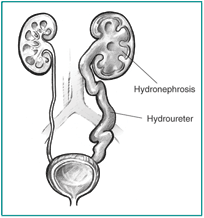

Vesicoureteral Reflux
Urine normally flows in one direction—down from the kidneys, through tubes called ureters, to the bladder. Vesicoureteral reflux (VUR) is the abnormal flow of urine from the bladder back into the ureters.
VUR is most commonly diagnosed in infancy and childhood after the patient has a urinary tract infection (UTI). About one-third of children with a UTI are found to have VUR. VUR can lead to infection because urine that remains in the child’s urinary tract provides a place for bacteria to grow. But sometimes the infection itself is the cause of VUR.

Vesicoureteral reflux (VUR) can cause swelling in the ureter and kidney, known as hydroureter and hydronephrosis.
There are two types of VUR. Primary VUR occurs when a child is born with an impaired valve where the ureter joins the bladder. This happens if the ureter did not grow long enough during the child's development in the womb. The valve does not close properly, so urine backs up (refluxes) from the bladder to the ureters, and eventually to the kidneys. This type of VUR can get better or disappear as the child gets older. The ureter gets longer as the child grows, and the function of the valve improves.
Secondary VUR occurs when there is a blockage anywhere in the urinary system. The blockage may be caused by an infection in the bladder that leads to swelling of the ureter. This also causes a reflux of urine to the kidneys.
Infection is the most common symptom of VUR. As the child gets older, other symptoms, such as bedwetting, high blood pressure, protein in the urine, and kidney failure, may appear.
Common tests to show the presence of a urinary tract infection include urine analysis and cultures.
Because no single test can tell everything about the urinary tract that might be important to know, more than one of the following imaging tests may be needed:
Kidney and bladder ultrasound: A test that uses sound waves to examine the kidney and bladder. This test shows shadows of the kidney and bladder that may point out certain abnormalities. The test cannot reveal all important urinary abnormalities or measure how well a kidney works. Voiding cystourethrogram (VCUG): A test that examines the urethra and bladder while the bladder fills and empties. A liquid that can be seen on x rays is placed in the bladder through a catheter. Pictures are taken when the bladder is filled and when the child urinates. This test can reveal abnormalities of the inside of the urethra and bladder. The test can also determine whether the flow of urine is normal when the bladder empties. Intravenous pyelogram: A test that examines the whole urinary tract. A liquid that can be seen on x rays is injected into a vein. The substance travels into the kidneys and bladder, revealing possible obstructions. Nuclear scans: A number of tests using radioactive materials that are usually injected into a vein to show how well the kidneys work, their shape, and whether urine empties from the kidneys normally. Each kind of nuclear scan gives different information about the kidneys and bladder. Nuclear scans expose a child to about the same amount of radiation as a conventional x ray. At times, it can be even less.
The goal for treatment of VUR is to prevent any kidney damage from occurring. Infections should be treated at once with antibiotics to prevent the infection from moving into the kidneys. Antibiotic therapy usually corrects reflux caused by infection. Sometimes surgery is needed to correct primary VUR.
Surgery is considered only when severe reflux has caused infection that can’t be controlled with antibiotics. The most common procedure to correct VUR is to sever the ureter from the bladder and then reattach it at a different angle so that urine can’t back up. In recent years, doctors have treated some cases of VUR by injecting a bulking agent into the bladder wall around the opening of the ureter where reflux happens. This procedure can be performed with a scope that reaches the inside of the bladder through the urethra, so the doctor doesn’t need to make an incision.
[Top]
Hope through Research
The National Institute of Diabetes and Digestive and Kidney Diseases (NIDDK) conducts and supports research to help people with urologic diseases, including children. The NIDDK’s Division of Kidney, Urologic, and Hematologic Diseases (DKUHD) maintains the Pediatric Urology Program, which supports research into the early development of the urinary tract. The DKUHD currently supports several researchers working to evaluate current treatments for VUR, particularly the use of antibiotics to prevent infection.
[Top]
For More Information
American Urological Association Foundation
1000 Corporate Boulevard
Suite 410
Linthicum, MD 21090
Phone: 1–800–828–7866 or 410–689–3700
Email: patienteducation@auanet.org
Internet: www.urologyhealth.org
You may also find additional information on this topic using the following databases:
The NIDDK Reference Collection is a collection of thousands of materials produced for patients and health care professionals, including fact sheets, brochures, and audiovisual materials. Visit www.catalog.niddk.nih.gov/resources.
MedlinePlus is the consumer version of MEDLINE with easy access to medical journal articles, medical dictionaries, directories, drug and supplement lists, interactive patient tutorials, publications, and the latest health news. Visit www.medlineplus.org.
National Kidney and Urologic Diseases Information Clearinghouse
3 Information Way
Bethesda, MD 20892–3580
Phone: 1–800–891–5390
TTY: 1–866–569–1162
Fax: 703–738–4929
Email: nkudic@info.niddk.nih.gov
Internet: www.kidney.niddk.nih.gov
The National Kidney and Urologic Diseases Information Clearinghouse (NKUDIC) is a service of the National Institute of Diabetes and Digestive and Kidney Diseases (NIDDK). The NIDDK is part of the National Institutes of Health of the U.S. Department of Health and Human Services. Established in 1987, the Clearinghouse provides information about diseases of the kidneys and urologic system to people with kidney and urologic disorders and to their families, health care professionals, and the public. The NKUDIC answers inquiries, develops and distributes publications, and works closely with professional and patient organizations and Government agencies to coordinate resources about kidney and urologic diseases.
Publications produced by the Clearinghouse are carefully reviewed by both NIDDK scientists and outside experts.
This publication is not copyrighted. The Clearinghouse encourages users of this publication to duplicate and distribute as many copies as desired.
NIH Publication No. 07–4555
November 2006
[Top]
|






